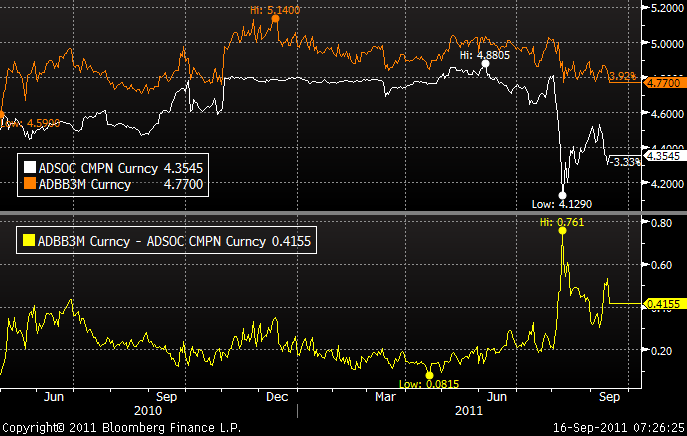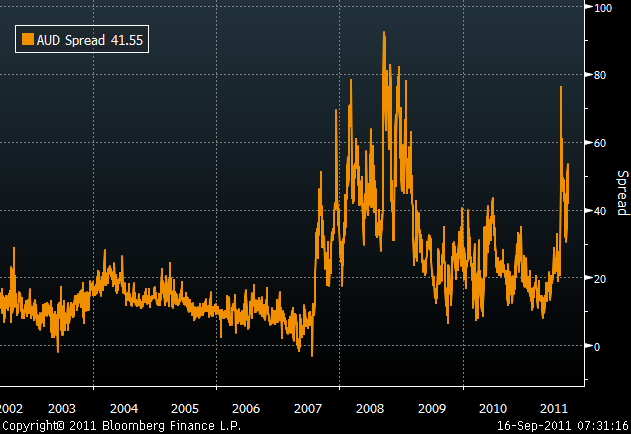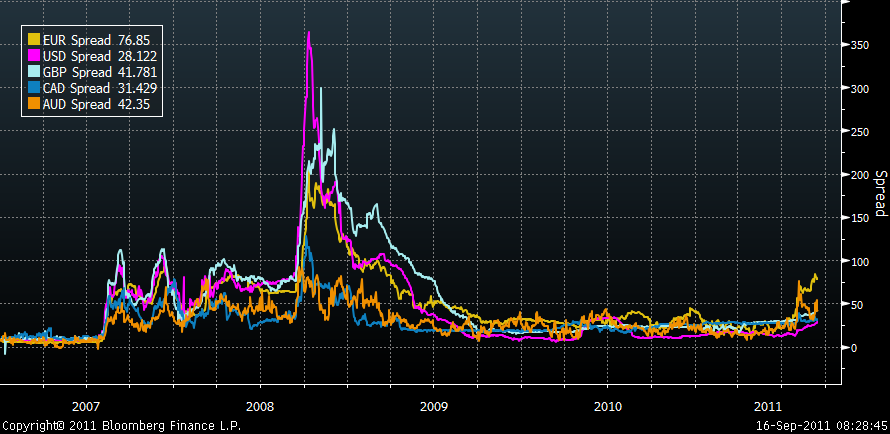MB has carried a lively debate this morning on interest rates and the bank’s vulnerability to wholesale funding. The Unconventional Economist quoted from the new RBNZ Financial Stability report to show that the New Zealand central bank is very concerned that markets are signaling that the Australian banks are just as vulnerable as they were during the GFC. That is, heavy falls in the equity price and a blowout in CDS spreads are suggesting the banks wholesale funding costs are going to come under pressure. Deus Forex Machina then argued that we’re going to see rate cuts in the medium term, just as credit markets are currently predicting.
I’m going to now bring these two discussions together to see what credit markets are telling us about Australian bank wholesale funding.
Here is a graph of the Overnight Index Swap (OIS) versus the 3 month bank bill swap rate (BBSW). The first is what credit markets are predicting for the RBA’s cash rate and the second is the price at which banks and other players will lend to one another in the short term.

Note the rather large spread that’s opened up between the market’s expectations for the official cash rate (in white) and the BBSW rate (in orange). The yellow line at the bottom charts the spread.
To make the point about how unusual this situation is, let’s take a look at the spread over a longer time frame:

As you can see, the GFC is the only other period where this spread has blown out in this way.
Could this be showing that although markets expect interest rates to be cut precipitously but they do not expect banks to be able to pass these rate cuts on?
There are a bunch of reasons why the interbank rate may not be tracking the OIS rate. Three of the major banks are approaching year end, and may not want to be caught holding large short term liabilities for a number of reasons.
Alternatively, bank bill rate traders within the banks may not agree with the credit markets assessment of coming rate cuts, so they don’t want to take on assets (bank bills) which carry a return lower than the cost of carrying those assets – the cash rate. But to the extent that the BBSW curve is inverted from 1 to 6 months (1 month BBSW is 4.80% while 3 month is 4.78% and 6 month is 4.57% this morning) suggests that there is some sympathy for the view by short term money market traders (both fund managers and bank books) that rates are going to fall but not soon enough yet to make up for the negative carry with capital gains.
All of these factors are probably at play. But, there’s one more chart that makes me think it’s more than that. Here’s the spread stacked against global peers:

The US and Great Britain, which led the interbank seizure in the last crisis, have risen mildly. Of the Western markets, only Australia and Europe have spiked in a way resembling the GFC.
It’s possible that once the majors get quarter and year end out of the way on September 30th that they’ll embrace the rally in the OIS, longer term swaps and futures markets and that BBSW rates will drop. But, when we add in what’s happened to Australian major bank CDS over the past few months my sense is that there is a creeping concern in Australian money markets which is being reflected in increased bank funding margins.
It’s important to remember that there are many moving parts in total ADI funding. Funding margins and funding rates aren’t the same thing and the combination of the increased flow of deposits, as well as the fall in the absolute rate of BBSW means that funding might actually be cheaper now than it was 2 or 3 months ago.

